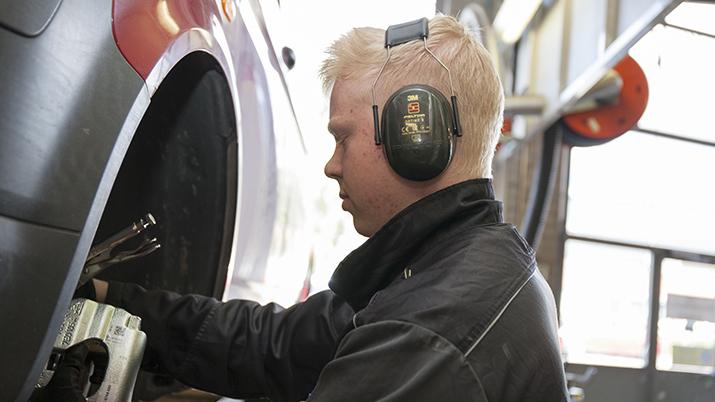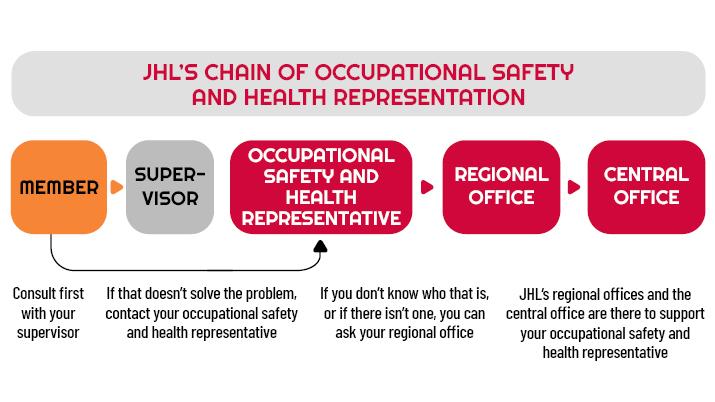Occupational safety and health and well-being at work
In your workplace, you have the right to occupational safety and health ("OSH") and well-being at work. You have the right to come home from work at least as healthy as you were when you went to work. The information on this page benefits your well-being at work. It also enables you to work in such a way that you won't have to be afraid of losing your health because of your job. This page also has information on what to do if you're unhappy with the occupational safety and health of your workplace, or with your well-being at work.
OSH and well-being at work are closely connected. OSH improves the well-being at work of you and your co-workers, and well-being at work affects how successful OSH is.
You have the right to work safely and without risking your health. You also have the right to well-being at work. It includes, say, a meaningful job, good atmosphere and leadership at work, professional co-workers and equal treatment in the workplace.
The employer is responsible for
- safety
- onboarding
- arranging occupational health services
- adjusting the work so that it fits the employee
- acquiring protective gear and aids
- taking OSH into account when planning and adjusting the work
- monitoring the working conditions
- early intervention in shortcomings
- stopping harassment and inappropriate treatment
In addition to rights, you also have responsibilities with which you can impact well-being at work and make OSH a success.
- complying with the employer’s instructions and orders
- complying with safe working methods, maintaining order and cleanliness, working in a careful manner
- using protective gear and aids
- ensuring that your work doesn’t cause danger to you or to the safety or health of others
- reporting faults and shortcomings to your supervisor and the OSH representative, or to the OSH ombudsman if there is one
- acting respectfully towards others.

You’re entitled to a safe work environment
Your workplace must have safe and healthy structures and materials along with a lighting and temperature that are suitable for work. Indoor air must be clean and ventilation must be sufficiently effective.
Your employer’s duty is to eliminate the dangers and harms of your work environment or keep them to a minimum. Dangers are assessed with risk assessment. The assessment takes into account working conditions, accidents that have occurred, close calls and occupational illnesses. One must also take into account the employee’s age, sex, skills and other personal prerequisites.
The assessment should be conducted at least every other year. This means that it is necessary to regularly look into all work-related dangers and harms in your workplace. Risks must also be assessed when starting a new job or when there are changes in a person's job.
- The first step is fixing the things that can be fixed right away.
- Notify of shortcomings to your supervisor and the OSH representative.
- Fixing the shortcoming is your supervisor’s responsibility. They must ensure that the shortcoming is fixed. There are also things that can’t be fixed right away. One must start with the problem that has been assessed as the most harmful one.
- A schedule is needed for fixing the shortcomings. The most urgent one of them must be fixed first.
If you detect a shortcoming in your workplace or working conditions, tell your supervisor and the OSH representative.
If your employer fails to take action in the matter, you can notify the OSH inspector of the shortcoming that applies to workplace safety or health.
JHL’s regional office can give you advice, but it cannot order the employer to take action.
Healthy working time benefits you
Having a regular daytime job is the most healthy way of working. However, it's increasingly common that work is performed every hour of the day. People adapt to irregularity to varying degrees. The ability to adapt is an individual quality, but it also depends on age. Shift work is worst suited for morning people. As a person gets older, their capacity to adapt to night shifts in particular decreases.
The harms of shift work can be decreased by, say, good shift planning and by taking into account individual needs. If you perform shift work, you should have a chance to participate in planning your work and shifts.
- regular rhythm
- fast, forward-rotating system
- 8–10-hour shifts
- 10–12 hours of rest between shifts
- uninterrupted periods of leave during the weekends
If you have questions related to working time, you can ask for help from the OSH representative or your shop steward. If your workplace lacks them, contact your trade union JHL’s regional office.
Your trade union JHL recommends the following for the performance of shift work:
- As few consecutive night shifts as possible (three at most)
- As few consecutive morning shifts as possible (three at most)
- As few consecutive evening shifts as possible (three at most)
- Forward rotation of night shifts (morning–evening–night). Backwards rotation should be avoided.
- There are at least two days off after the last night shift of the period. The night–morning period should be avoided.
- Avoid individual days off.
- Avoid individual working days.
- The maximum number of consecutive working days should be 5–7.
- There should be enough rest between shifts (over 11 hours).
You can consider long shifts if
- they fit the nature of your work and your workload
- you can take enough many breaks from work
- the shift system is well designed and there is enough leisure time between shifts
- absences are covered with sufficient back-up personnel
- you’re not required to perform overtime work
- there is a limited exposure to substances that are dangerous to your health
- you have the chance to recover very well/perfectly from work.
Occupational health is your right
In Finland, the law obligates the employer to arrange preventive occupational health services for all its employees who work in Finland. The law also applies to foreign employers and private individuals acting as employers, even if they only have one employee. Whether your employment relationship is valid until further notice or fixed term, and whether you perform full-time or part-time work, occupational health is your right.
Statutory occupational health services include work-related health checks, workplace surveys, supporting work ability and looking into illnesses or symptoms that are connected to the work.
Remember that you’re also entitled to get advice and guidance related to your work and occupational health from occupational health professionals on, say, ergonomics.
It is voluntary for employers to offer medical treatment and other services provided by occupational health.
Many employers wish to provide their employees with a more extensive occupational health service than what the law stipulates, because a prolonged period of illness is an inconvenience to the employee and employer.
Notify your superior of this in writing and ask why they're not provided although the Occupational Health Care Act obliges the employer to do so. You will then have a document on the fact that you’ve only demanded what you're entitled to.
You can ask for advice from the OSH authority that supervises your workplace.
See also:
Occupational healthcare as support at the workplace during change (The Centre for Occupational Safety)

Support for coping at work
The basic prerequisites for coping at work are proper working conditions, necessary competence, meaningful work, work ability and work-life balance.
Proper working conditions refer to a safe workplace where everything is in order with working conditions, management and work arrangements, and there is a suitable amount of work.
The difficulty and variability of your work, and the chance to learn new things, are connected to your competence. You need to have a chance to learn as your work changes. The passage of time changes both you as an employee and your work. Aiming for things to stay the same is not something you should needlessly strive for.
You are not a machine.
Manage your workload
Workload refers to both physical and mental work strain. A reasonable workload doesn't harm your health if you can recover from it every day. A reasonable workload promotes your well-being and the prerequisites for smooth work. A prolonged, excessive workload may cause harm to your health and the smoothness of your work.
Physical burden at work includes bad working arrangements, working positions and movements, unsuitable tools, and the use of physical strength.
Mental burden at work (mental, psychosocial strain) can be caused by, say, constant hurry, unclarity about work goals, a lack of possibilities to make a difference, interruptions, a large amount of responsibility, communication between co-workers, and a lack of cooperation.
Mental burden that puts a strain on brain work (cognitive burden) can be caused by for instance hurry, constant interruptions, information coming from several communications channels, the number of things that need to be remembered, and several simultaneous tasks.
- Participate in looking into and evaluating the factors that affect your workload. It is the employer’s duty to look into them in the workplace.
- Plan your work in such a way that the various work duties form a well-functioning whole.
- If possible, take breaks from work. Taking breaks promotes your recovery.
- Organise your workspace in such a way that you have enough room to work safely.
- Pay attention to your working position. Is it balanced or well supported? Can you change your position freely?
- Utilise easy-to-use tools and aids.
- You can increase resources with, say, flexible working time and by fine-tuning your work.
- Clear goals for work: If the goals for your work are unclear, talk to your supervisor about what the goals are, who’s in charge and what they're in charge of.
- Aim to keep the workload and the pace of work reasonable and suitable for you.
- Increase the possibilities to impact your work. Could you carry out duties that require various kinds of skills or determine goals for your work, your working method or the rhythm of your work?
- Look after your competence. If you have training-related aspirations, a performance appraisal is one opportunity to express them.
- Ask or request feedback from your supervisor and co-workers on the work that you’ve done. Feedback is a sign that your work is noticed. At its best, feedback gives more strength, results in work engagement and encourages to get better.
- Social relationships and social support are important sources of well-being and strength, both in working life and in your private life. Networking happens when you meet and get to know other people. However, you yourself should be active even then. Networks are important for transmitting information and sharing ideas, updating skills and further developing competence. They also support you in challenging situations.
- If possible, take a break before you move from one work task to another. Taking a break helps “reset” the brain from the attention required by the previous task.
- Situations in which negative emotions arise are a burden if you must suffocate your emotions or pretend to feel them. Symptoms of emotional burden include tiredness, irritability and concentration difficulties. You can unload some of your emotional burden by talking with your co-workers or superior, taking breaks from work, directing your thoughts to the things that went well after the working day, and focusing on what you could do to make you happy.
- Diminish multitasking, do one thing at a time.
- Schedule, i.e. plan when you’ll carry out which task. Try to minimise interruptions.
- Put your tasks in an order of importance.
- Perform difficult tasks when you’re alert.
- Limit the flood of information.
- Set aside time in your calendar for learning new things.
- If possible, delegate tasks to your co-workers.
More information:
- The Abilitator® supports work ability and functioning
- Workload Assessment Tool

Tips for after-work recovery
After-work recovery is essential for coping at work. Holidays and days off alone are not enough. You also need to recover during your working day. Recovery during a working day means interrupting your work for a short time and concentrating your thoughts and actions on something else than the work at hand.
- If you perform physical labour, your recovery is promoted by pause exercise, chatting with a co-worker or stopping for a moment to, say, look out the window.
- If you do sedentary work, the best kind of recovery is walking for a couple of minutes every half an hour according to research conducted by the Finnish Institute of Occupational Health (FIOH).
Coping at work and recovery are also promoted by exercise, a healthy diet and sleeping. The choices that you make affect them all. Visit the Workplaces on the Move website.
Equality and non-discrimination in working life
Trade Union JHL always stands up for justice and does not accept any kind of workplace discrimination, racism or bullying. Each employee is valuable and important just the way they are.
Promoting equality and non-discrimination in working life and work communities is of absolute significance. Shop stewards and occupational safety and health representatives are personnel representatives and support persons trained by JHL. You can always turn to them in matters related to equality, too.
The purpose of the publication named “Diversity, equality and non-discrimination in the work community” is to support workplaces in promoting equality and non-discrimination. The publication also helps with leading diversity and taking it into account.
Diversity refers to the differences between various people in regard to characteristics such as gender, ethnic or national background, language, beliefs, health, nationality, work ability or educational background.
The requirements of the Equality Act and Non-discrimination Act are at the centre of the information package. JHL encourages workplaces to adopt the practices and modes of operation presented.
JHL’s Working Life Specialist Tuula Haavasoja has been involved in drawing up the publication. Check it out! Diversity, equality and non-discrimination in the work community - the Centre for Occupational Safety (ttk.fi)
The purpose of the Equality Act is to prevent discrimination based on sex, gender identity or gender expression. The Act also aims to further promote equality and improve women’s position in working life.
Employers are obligated to further promote equality in a planned and purposeful manner. If a workplace has over 30 employees, the employer must draw up an equality plan at least every other year. The plan must be drawn up in cooperation with personnel representatives (for instance with an occupational safety and health representative or a shop steward).
According to the Non-discrimination Act, no one may be discriminated against on the basis of, say, gender identity, sexual orientation, ethnic background, religion, health or some other personal feature. Furthermore, employers are obligated to further promote non-discrimination in the workplace. Workplaces with more than 30 employees must have a plan on measures that further promote non-discrimination. In addition, occupational safety and health representatives and shop stewards have the right to find out, upon request, which non-discrimination measures the employer has taken.
What to do if you encounter bullying, discrimination or harassment in the workplace:
- If you have been treated unfairly and you cannot ignore the matter with a shrug, take up the matter with the person who offended you. Tell them that you do not accept their behaviour or actions. Specify clearly how their actions are inappropriate. Ask them to stop their offensive behaviour or actions. You can ask an occupational safety and health representative, a shop steward or co-worker to assist you.
- If you are unsure of what to do, contact the occupational safety and health representative, shop steward, your supervisor or your occupational health services.
- If the inappropriate treatment continues, ask your supervisor to intervene in the matter. If your supervisor takes no action, or if the person behaving inappropriately is your supervisor, contact their supervisor.
- If your workplace takes no action despite your request, contact the occupational safety and health authority. You can ask an occupational safety and health representative or a shop steward to assist you.
Discrimination or harassment is never acceptable. Nobody should have to face bullying in the workplace. One must always intervene in offensive situations.
Also see the instructions by the Centre for Occupational Safety: What to do if you suspect that you have been discriminated against at work
Where to get help if you can’t cope at work
If you’re having difficulty coping at work, try to figure out why, and think of ways to keep going.
- Performance appraisal gives you the chance to bring up things that impede work if you haven’t talked about them with your supervisor before.
- An OSH representative can act as your support person in dealing with matters and taking them forward.
- Occupational health services are at hand if your health is in danger. However, sick leave is not a way to fix the problems that there are at work. Work-related issues need to be dealt with in the workplace.
- You get peer support by attending JHL’s events. There are empowering events available. Keep an eye on the course and event calendar (in Finnish) on our website!
- You can also get peer support by taking part in JHL’s courses. Courses are arranged by the regional offices, JHL Institute and JHL’s occupation-specific activities unit. Keep an eye on our course and event calendar.
- Every year, JHL applies for Kela’s vocationally oriented KIILA rehabilitation for members. If your work ability is in danger, this rehabilitation may be a good option for you.

OSH representative is at hand
The OSH representative represents all employees – not just JHL members – in matters related to safety and health. You can contact the representative in all matters related to occupational safety, occupational health or well-being at work.
A representative must be elected in workplaces with at least 10 employees. However, even in smaller workplaces the employees can, if they wish, elect an OSH representative amongst themselves.
Your workplace may also have some other OSH actor with the title of
- deputy OSH representative
- OSH ombudsman (in municipalities and wellbeing services counties the title is OSH contact person)
- OSH manager (functions as an employer representative and helps supervisors in OSH matters)
You can also contact them in matters related to occupational safety and health.

Do you want to get involved in managing OSH affairs?
Are you interested in improving the occupational safety and health of your workplace even further? As an OSH representative, you have the chance to make a difference in your workplace and cooperate with your employer to make the workplace an even better place to work. The representative’s term of office is, depending on the agreement sector, from two to four years.
Your union will provide you with free OSH training. You’ll be paid a full salary during training.